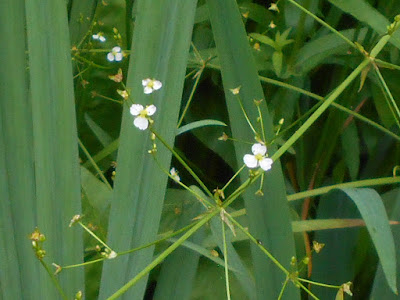Speaking of the pond, last time I visited it I got a slightly better picture of the Water Plantain. It belongs to a small but particularly interesting plant family, the Alismataceae.
 |
Water Plantain, Alisma plantago-aquatica grows in the little pond at
Stefen Hill Pocket Park.19 July, 2019 |
Many people, even non-botanists, will be aware that the world of flowering plants can be divided into two groups. First there are the monocotyledons - nowadays generally shortened to monocots - with strap-shaped or sword-shaped leaves. The leaves have near-parallel veins running the length of the leaf and the group includes grasses, daffodils, irises, orchids and the like. They rarely form trees, palm trees being one of the exceptions. Then there are the dicotyledons - dicots - whose leaves may be heart shaped, oval or divided like the rather well-known cannabis plant; they may even be split into separate leaflets, like the horse-chestnut. Dicots include many trees.
The Alismataceae are monocots yet their leaves could easily be mistaken for those of a dicot (the strap-shaped leaves in the first picture are those of yellow iris). Yet the structure of the flower - the petals, sepals and stamens - are extremely similar to those of buttercups, and particularly spearworts, in the dicots. But the rather blurred picture, lifted from the internet, shows that the spearworts have the strap-shaped leaves similar to those of a monocot.
The situation has exercise the minds of botanists for a century or more and now modern techniques of genetic analysis may provide some answers.

No comments:
Post a Comment